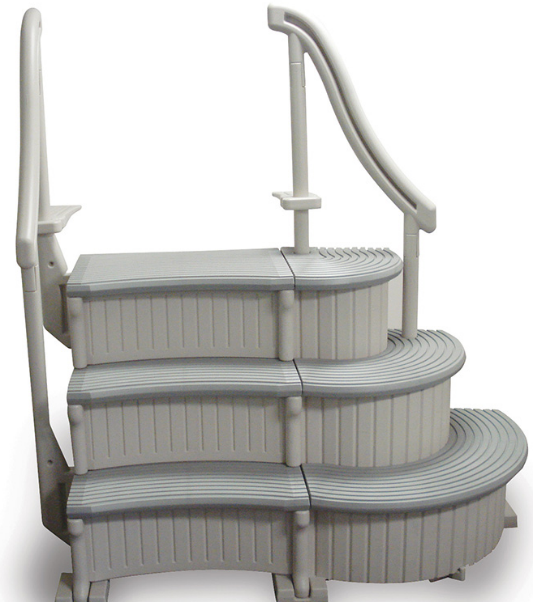
If you have a pool and children and you use a pool step system to help your child get into or out of the pool safely, you should pay attention to this. Confer Plastics has recalled about 100,000 in-pool step systems with curved steps for in-ground and above-ground pools after a number of reports of children being injured by using them, including at least two reports of children’s arms becoming entrapped in the side openings of the step systems, thus creating a potential drowning hazard.
Thankfully, so far, no drownings have been reported, although there have been reports of minor abrasions and Confer Plastics noting the hazards caused when a child’s limbs become trapped.
Which Systems Are Being Recalled?
This recall involves the following products:
- Confer Curve base (staircase) 4-step for an above ground pool, model #CCX-AG
- Confer Curve base (staircase) 3-step for an in-ground pool, model #CCX-IG
- Curve add-on unit for either in-ground or aboveground stairs, model #CCX-ADD
All three models above feature curved steps and the steps and handrails are made with gray and beige plastic. The in-pool step systems are affixed with a manufacturing/date code on the side walls of each step. These step systems were sold at a number of retailers nationwide, both in stores such as Leslie’s, Champion Pool Distributors, EMSCO Distributors, Leisure Living, Cinderella, Superior Pool Products and Water Warehouse stores, among others. They were sold between January 2013 and July 2018 for between $200 and $400.
Consumers who have these step systems are being asked to discontinue their use immediately and contact Confer Plastics for a free repair kit, which will include additional panels designed to prevent entrapment. The kits will include installation instructions.
Keeping Kids Safe Around Water – Some Tips
This recall reminds us that, while jumping into the water is a fine way to beat the Texas summer heat, the summertime is also the time of year when a child is most likely to drown. So far, in 2018, more than 70 children have drowned in Texas, including six in Bexar County alone. Of those six, four of them were aged four or under and one other was just 7.
According to the Texas Drowning Prevention Alliance, in our state drowning is the 2nd leading cause of death among children under 14 years of age. They also note that, for every child who fatally drowns, at least five others suffer non-fatal submersion injuries that require emergency care. For children four and under, drowning results in more deaths than any other cause. While some of these drowning deaths occur in the bathtub, the other 90 percent are not.
It is hard to imagine the horror a family feels at losing a young child. What’s even more tragic is, virtually all drownings The sad part is, almost all drownings are preventable if only adults watched all kids when they play around water. When infants or toddlers are in or around water, an adult shouldn’t just be watching them; they should be within an arm’s length of the child. It may seem difficult to provide active supervision in our multi-tasking world, but there is no substitute for hands-on supervision when they are that small. Some parents have taken to going to the pool together and designating one adult as a “Water Watcher” for a certain period of time, with parents rotating the responsibility every half hour to an hour or so. This prevents lapses in supervision. No child should be unsupervised when they are around water, whether they are indoors or outside the house. That means any amount of water; even a small amount of water in a bucket can be deadly in some circumstances.
Parents and other adults also are encouraged to introducing babies to the water early, starting at about six months of age. And all children should be taught to swim safely. Children should be taught to tread water, float and also to stay out of the water when no adult is present. Teach them to only swim in designated areas and that swimming in open water is different from swimming in the pool. However, wherever they swim, they should stay out of the water unless an adult is present.
Use The Proper Water Safety Equipment
Experts also warn adults that swimming aids like water noodles and water wings can be fun toys, they should never be used in place of a Coast Guard approved personal flotation device. In other words, never think of water wings as a usable substitute for a life jacket because it’s not.
In a backyard pool, make sure there is proper fencing surrounding the pool and that all gates are secure as required by law. Experts also recommend teaching children about the dangers posed by pool drains, especially the dangers of entanglement and entrapment. Teach them to stay away from the pool drain altogether. Make sure all drains are secure and have no cracks and replace flat drain covers with those with a dome-like shape. Never use drain covers that are broken or loose.
Once again, this recall should serve as a reminder that keeping children safe around water is a full-time job, and sometimes takes more than one of us. Our children are our most precious resource and we should take care of them. If you have this step system, take the recall seriously and fix it. However even if you don’t, most drownings are preventable, so do your best to try.
